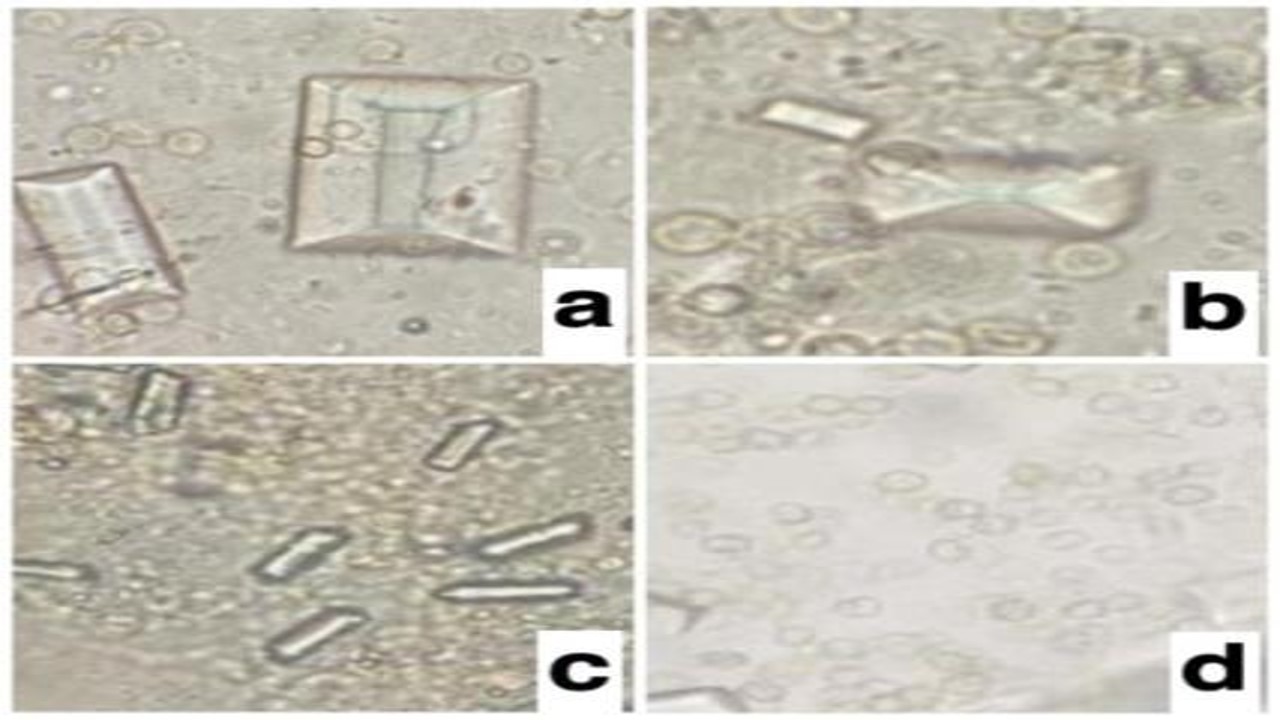Risk Factors and Incidence of Feline Lower Urinary Tract Disease (FLUTD) in Sahabat Satwa Genteng Animal Clinic

Downloads
The purpose of this study was to determine the risk factors and incidence of Feline Lower Urinary Tract Disease (FLUTD) at the Sahabat Satwa Genteng clinic. A total of 36 samples were evaluated according to research procedures with diagnosis, data collection, urine sampling, dipstick and sediment examination methods, and Chi-square data analysis. The results showed that there was a association between gender, history of castration, and diet on the risk of FLUTD. Meanwhile, there was no association between age and the risk of FLUTD. Clinical signs that often occur in FLUTD disease initiate from stranguria, hematuria, dysuria, periuria, and polykisuria. The results of the dipstick examination founded that 86,1% of cats affected by FLUTD had a normal pH and 13,9% had an alkaline pH. The results of the specific gravity (SG) of cats with FLUTD have values below normal while the protein levels found in all cats suffering from FLUTD have values above normal. Stranguria was found in 69,4% of cats with FLUTD. Leukocytes were also found in all the urine of cats suffering from FLUTD. The most common results of sediment examination were struvite, calcium oxalate, and cystine crystals.
Abdel-Saeed, H., Tahon, R., & Farag, H. (2020). Diagnostic And Epidemiological Studies On Obstructive Feline Lower Urinary Tract Disease (Flutd) With Special Reference To Anatomical Findings In Egyptian Tomcats. Bulgarian Journal of Veterinary Medicine, 19(1).
Ackerman, N. (2012). The consulting veterinary nurse. Veterinary Nursing Journal, 27(7), 269-270.
Astuty, A. T. J. E., Tjahajati, I., & Nugroho, W. S. (2020). Detection of feline idiopathic cystitis as the cause of feline lower urinary tract disease in Sleman Regency, Indonesia. Veterinary World, 13(6), 1108.
Chandra, D. A., & Kautsar, A. P. (2016). Penggunaan Dipstick sebagat Alat Diagnosis Infeksi Saluran Kemih pada Kondisi Tertentu. Farmaka, 14(1), 1-7.
Christoper, M. M. (2004). Urinalysis and Urine Sediment. Disampaikan pada World Small Animal Veterinary Association World Congress Proceedings. Greece.
Defauw, P. A., Van de Maele, I., Duchateau, L., Polis, I. E., Saunders, J. H., & Daminet, S. (2011). Risk factors and clinical presentation of cats with feline idiopathic cystitis. Journal of Feline Medicine and Surgery, 13(12), 967-975.
Denenberg, S. (2020). Small Animal Veterinary Psychiatry. CABI. pp: 33.
Dorsch, R., Hartmann, K., & Sauter-Louis, C. (2014). Feline lower urinary track disease in a German cat population: A retrospective analysis of demographic data. Kleintiere Heimtiere, 42(4), 231-239.
Fauziah, H. (2015). Gambaran Cystitis Melalui Pemeriksaan Klinis dan Laboratoris (Uji Dipstik dan Sedimentasi Urin) Pada Kucing di Klinik Hewan Makassar. [Skripsi]. Fakultas Kedokteran, Universitas Hasanuddin Makassar.
Fitriah, N., Rosa, F., Hermawanti, M., & Setiyowati, R. (2018). PF-5 Case Study: The FLUTD (Feline Lower Urinary Tract Diseases) Incidence on Cats in Qithmir Pet Care Jombang Year 2013-2017. Hemera Zoa, 2(1).
Gopala, J. (2016). Pengaruh Kecepatan Sentrifugasi terhadap Hasil Pemeriksaan Sedimen Urin Pagi Metode Konvensional. Skripsi.
Holt, P. E. (2008).Urological Disorders of the Dog and Cat: Investigation, Diagnosis, Treatment. Manson Publishing. Barcelona. pp: 14.
Kakanang, P., Sahatchai, T., Niyada, T., Phatthamaporn, L., & Atiratt, K. (2020). Prevalence and risk factors of feline lower urinary tract disease in Chiang Mai, Thailand.Scientific Reports (Nature Publisher Group), 10(1).
Lalor, S. M. (2011). Feline lower urinary tract disease and Purina Veterinary Diets (R) Feline Ur St/Oxâ„¢. The Veterinary Nurse, 2(7), 388-393.
Lew-Kojrys, S., Mikulska-Skupien, E., Snarska, A., Krystkiewicz, W., & Pomianowski, A. (2017). Evaluation of clinical signs and causes of lower urinary tract disease in Polish cats. Veterinární Medicína, 62(7), 386-393.
Lund, H. S., Krontveit, R. I., Halvorsen, I., & Eggertsdottir, A. V. (2013). Evaluation of urinalysis from untreated adult cat with lower urinary tract disease and healthy control cat: Predictive ability and clinical relevance. Journal Feline Medical Surgery, 15(12), 1086-1097.
Malmasi, A., Nazar, T., Mojtahedzadeh, M., Bokaei, S., Mokhtari, R., Babazadeh, S., & Tavallaie, S. (2019). Therapeutic effects of parenteralvitamin C (ascorbic acid) on struvite crystalluria in domesticmale cats. Iran Journal Veterinary Medicine, 13, 233-242.
Martinez-Ruzafa, I., Kruger, J. M., Miller, R., Swenson, C. L., Bolin, C. A., & Kaneene, J. B. (2012). Clinical features and risk factors for development of urinary tract infections in cats. Journal of Feline Medicine and Surgery, 14(10), 729-740.
Men, Y. V., & Arjentina, I. P. (2018). Laporan Kasus: Urolithiasis Pada Anjing Mix Rottweiller. Indonesia Medicus Veterinus, 7(3), 211-218.
Mongan, R., Supiati, S., & Mangiri, S. (2017). Gambaran Sedimen Urine Pada Masyarakat Yang Mengkonsumsi Air Pegunungan Di Kecamatan Kendari Barat Kota Kendari. Jurnal Teknologi Laboratorium, 6(1), 18-24.
Nelson, R. W., & Couto, C. G. (2009). Small animal internal medicine. Textbook of Veterinary Internal Medicine, 4th Ed. Mosby/Elsevier, St. Louis.
Saevik, B. K., Trangerud, C., Ottesen, N., Sí¸rum, H., & Eggertsdóttir, A. V. (2011). Causes of lower urinary tract disease in Norwegian cats. Journal of Feline Medicine and Surgery, 13(6), 410-417.
Sari, D. A. K., & Yulianto, A. B. (2017). Pengaruh pemberian antibiotika amoksisilin dan tetrasiklin terhadap gambaran urine pada kucing lokal (Felis catus). Agrovet, 5(2), 143-151.
Schmiemann, G., Kniehl, E., Gebhardt, K., Matejczyk, M. M., & Hummers-Pradier, E. (2010). The Diagnosis of Urinary Tract Infection: A Systematic Review. Deutsches í„rzteblatt International, 107(21), 361-367.
Stockhom, S. L., Scott, M. A. (2002). Fundamental of Veterinary Clinical Pathology. Toronto: Iowa State Press. pp: 41.
Copyright (c) 2023 Hani Plumeriastuti, Seline Putri Novitasari, Arimbi, Maya Nurwartanti Yunita, Iwan Sahrial Hamid, Prima Ayu Wibawati

This work is licensed under a Creative Commons Attribution-NonCommercial-ShareAlike 4.0 International License.
Authors who publish in this journal agree to the following terms:
1. The journal allows the author to hold the copyright of the article without restrictions;
2. The journal allows the author(s) to retain publishing rights without restrictions;
3. The legal formal aspect of journal publication accessibility refers to Creative Commons Attribution-NonCommercial-ShareAlike 4.0 International License (CC BY-NC-SA).





11.jpg)




















